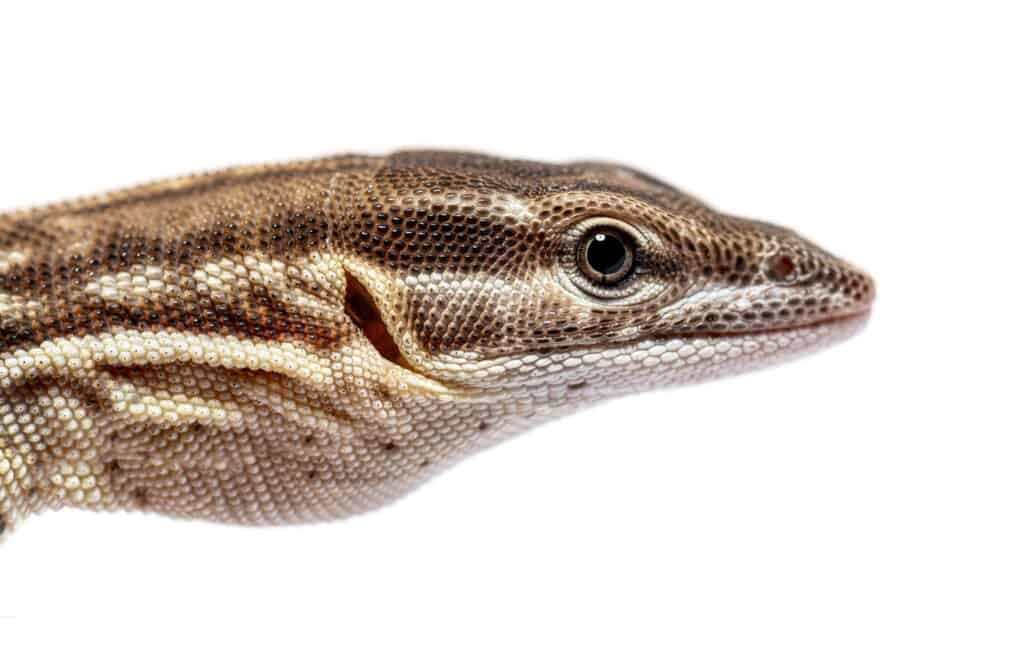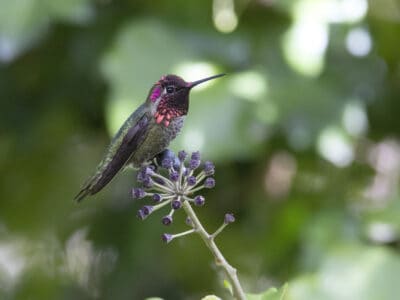Ackie Monitor
Varanthus acanthurus
The ackie monitor has a spiny tail which it uses as in self-defense.
Advertisement
Ackie Monitor Scientific Classification
- Kingdom
- Animalia
- Phylum
- Chordata
- Class
- Reptilia
- Order
- Squamata
- Family
- Varanidae
- Genus
- Varanus
- Scientific Name
- Varanthus acanthurus
Read our Complete Guide to Classification of Animals.
Ackie Monitor Conservation Status
Ackie Monitor Facts
- Prey
- arthropods such as cockroaches, beetles, crickets, caterpillars, and small rodents, small lizards
- Name Of Young
- hatchling
- Group Behavior
- Solitary
- Mainly solitary
- Fun Fact
- The ackie monitor has a spiny tail which it uses as in self-defense.
- Biggest Threat
- Raptors, snakes, bigger monitor lizards, metabolic bone disease
- Distinctive Feature
- red or yellow spots and stripes on head and tail
- Other Name(s)
- spiny-tailed monitor, ridge-tailed monitor, ackie dwarf monitor
- Temperament
- Docile
- Incubation Period
- Five to seven months
- Habitat
- Arid scrublands, woodlands
- Predators
- Snakes, raptors, bigger monitor lizards
- Diet
- Carnivore
- Average Litter Size
- 6 to 18 eggs
- Lifestyle
- Solitary
- Diurnal/Nocturnal
- Favorite Food
- insects, mealy worms, waxworms, small rodents and reptiles
- Common Name
- Ackie monitor
- Origin
- Australia
- Number Of Species
- 2
View all of the Ackie Monitor images!
The ackie monitor has a spiny tail which it uses as in self-defense.
Ackie Monitor Facts
- Although “ackies” is a nickname, herpetologists and animal professionals use to call ackie monitors.
- In their natural rocky habitats, they benefit from the pattern of their skin which serves as camouflage against predators.
- In the wild, color generally correlates with the color of the soil and rocks in their habitat as a form of camouflage.
- In the wild, they mostly use their spiny tails as a means of self-defense against predators. When threatened, they wedge themselves in-between rock crevices and block the opening with their tails.
- Ackie monitors come in two colors: red and yellow. There is no major difference between these two types, except in size. Red ackie monitors are generally bigger than the yellow ones and have longer tails.
- These lizards are one of the smaller species of monitor lizards and are prey to larger monitors.
- Yellow ackie monitors are one of the best monitor lizard pets to have. They can develop a deep bond with their owner.
- They originated in Australia. They prefer dry, hot climates and burrow underground to keep humidity and temperature under control.
Ackie Monitor Summary
They are one of the smaller species of monitor lizards. Their name comes from the pronunciation of their specific name “acanthurus.” In addition to this, they are also called spiny-tailed monitors because of their spiny tails which they use for self-defense. They come in two colors, red and yellow, with the red ackie monitors being the larger type. They are active lizards and known to make great pets, provided the proper space and diet.
Ackie Monitor Scientific Name
The scientific name of the ackie monitor is Varanus acanthurus. The name “ackie” comes from the pronunciation of the Latin specific name “ACK-anthurus.” They are also called ridge-tailed monitors, spiny-tailed monitors, or ackies dwarf monitors.
They were once divided into three subspecies:
- Red ackie monitor
- Yellow ackie monitor, and
- Island ridge-tailed monitor
Although originally thought to be different species, DNA tests have proven that the red and yellow ackie monitors are the same species and are both Varanus acanthurus. The fate of the Island ridge-tail monitor (Varanus acanthurus insulanicus), however, is still under heavy speculation after DNA analyses and research by ecologists to be a different species from the former two entirely.
They belong to the Varanidae family with other carnivorous lizards such as the Asian water monitor and Blackthroat monitor.
Ackie Monitor Appearance

Ackies are docile, curious, and intelligent lizards.
©Eric Isseelee/Shutterstock.com
Ackie monitors are generally medium-size, lengthy and slender lizards. They have short legs, tapered snouts, a snakelike tongue, and a long tail. Their tail is so long, it makes up over half of the lizard’s entire length. It also cover in scales which resemble spines, hence their nicknames. They typically have three pale stripes on their pointed head that streak down to their neck.
Red and yellow ackie monitors are classified by the colors of the spots on their backs. Their bodies are usually brown, black-brown, or red with red, cream, or yellow spots. Their undersides are typically pale and bare.
Red ackie monitors are much larger than yellow ackies, and rarer as well. They are dark brown with reddish-orange spottings with dark spots inside them. Around the tail, these spots transform into stripes.
Yellow ackie monitors look almost exactly like their red counterparts, all except the coloring. Yellow ackies have base colors ranging from brown to a dark golden and are covered in spots that are yellow, yellowish-orange, and cream. The pattern of these spots transform into stripes as it gets to the tail, similar to the red ackie monitor. Yellow ackies typically have shorter tails then red ackies.
Although red ackies are larger than yellow ackies when it comes to size, both of these monitors are still relatively small compared to most other monitor lizards. They are known as “dwarf” monitors for this reason. They are usually about two feet long, with their tails making up half of this length, but some have been recorded to be as small as 17.3 inches and up to two and a half feet.
Males are usually bigger than the females and have more pronounced features such as larger, bulkier heads, and coarse spines under their tails. Female ackies have smaller heads and smooth scales under their tails.
Ackie Monitor Behavior
They are docile, curious, and intelligent lizards. Yellow ackies are usually kept as pets rather than red ackies. They make some of the best monitor pets, given the proper care and shelter they require. They have a good temperament and can live in captivity for up to 15-20 years. Ackie monitors are gentle and do not typically get defensive unless mishandled, or afraid. When handling them, it is important to start small by caressing the lizard first before picking it up. You can also be present in their enclosure for periods of time without touching them to allow them to get used to you.
Ackie monitors in the wild mostly use their spiny tails as a means of self-defense. When threatened, they wedge themselves in-between rock crevices and block the opening with their tails.
These reptiles are diurnal, which means that they are active during the day and prefer rest at night. They also prefer hot weather, basking in temperatures as hot as 172 degrees Fahrenheit as opposed to cooler night weather around 65 degrees Fahrenheit.
Ackie monitors are very active lizards, and as such, great care and attention must be provided to those in captivity. This species cannot thrive in a small environment. They require abundant space, which can be expensive. Ackie monitors are a burrowing species, and spend considerable amounts of time underground. They also need enough space to be able to move around and climb.
While some handlers have successfully kept more than one ackie monitor in the same enclosure, this is not advisable. They are solitary animals and should be kept in separate enclosures.
Ackie Monitor Habitat and Population
Ackie monitor lizards are terrestrial lizards with origins in the arid woodland and scrubland areas of the north, west, and center regions of Australia, as well as some of the islands off of the northern coast of the continent. The red ackie monitor lizards are typically located in the northwestern part of Australia while the yellow ackie is predominant in the central part of the country.
Ackie monitor lizards prefer hot, dry weather with enough rocks and boulders which provide them with crevices to shelter in, including burrowing space. These burrowing spaces are especially dire for the ackie monitor lizards as they enable them to control and regulate their temperatures and humidity. They rely greatly on the humidity from these burrows to keep them hydrated enough to withstand the dryness of their environments.
Ackie monitors that are kept as pets are predominantly bred in captivity. The ackie monitor is listed as Least Concern on the IUCN Red List of Threatened Species.
Reproduction and Lifespan
The ackie monitor can have a lengthy and full life if kept in good and stable conditions. In captivity, it can live 15-20 years.
If you ever get stuck trying to tell the male ackie monitors from the females, you can try observing some of their physical traits. Female ackie monitors are usually smaller with narrower heads and smooth scales under their tail. Male ackie monitors are larger in size, have bulkier heads and coarse scales under their tail. If this isn’t accurate enough for you, you can try the hemipenal transillumination method, which involves using a non-heating light source around the tail of the animal to determine its sex.
In the wild, the mating season for ackie monitors usually take place from December to March. Breeding occurs from spring to summer. However, in captivity, it can occur at any given time. The males initiates the process, and the male and female can typically mate on and off for a period of about five days. After this, the female locates a good spot with a temperature of around 86 degrees Fahrenheit to lay her eggs. Once a suitable spot is located, the female monitor will dig tunnels and lay her eggs there in about 20 days, after which she will require enough food and water to nurse herself back to health.
When it comes to sexual reproduction, females have it quite hard. Therefore, it is important to make sure that they are of optimal health before considering breeding. If the nutritional and temperature conditions are optimal, the female monitor can produce more clutches of eggs. Females can lay up to 6 clutches annually, providing around 6-18 eggs per clutch.
The ackie monitor offspring will hatch after three to five months of incubation. The hatchlings measure about six inches. Maturation for males occurs when the young lizard measures 12 inches, and the females 10-14 inches. Adults reach lengths of two to two-and-a-half-feet.
Ackie Monitor Diet
Ackie monitors are carnivorous lizards, feeding primarily on arthropods and other invertebrates such as caterpillars, worms, spiders, grasshoppers, snails, crickets, cockroaches, beetles, ticks, and cicadas. They also prey on smaller lizards, such as geckos and skinks, and this feeding source accounts for around one-third of its diet. Whole animal prey such as small rodents can also be given to the ackie monitor sporadically, depending on the weight of the lizard in order to prevent obesity.
Pet monitor owners should consider that since about 70% of the ackie monitor’s water source comes from the food it eats, it should be given prey items which can provide this amount. Owners might get tempted to go the easy route and feed your ackie monitor pet regular cat or dog food, but this is not a good idea. Monitor lizards have a different digestive system from your other mammalian pets and these canned and processed foods will not provide your monitor with its proper dietary requirements.
For ackie monitors in captivity, it is advised that calcium and vitamin powder supplements be brushed onto their food items to supplement their daily requirements. This is important as it will help prevent bone diseases that monitor lizards in captivity are susceptible to.
Ackie Monitor Predators and Threats
In the wild, they get preyed upon by snakes, raptors, as well as other monitor lizards. Since they are a smaller species of monitor lizards, these predators hunt the adults, the juveniles, and even eat their eggs.
Ackie monitors in captivity mostly face health-related issues. One of such issues is metabolic bone disease (MBD) which results from inadequate calcium intake. Lack of calcium to fortify the bones of the lizard causes the bones to become weak and fragile, leading to movement restriction and, eventually, death.
Another health issue that ackie monitors in captivity could potentially face is obesity. This comes as a result of excess feeding, and also feeding lizards with too much fatty prey such as mealy worms and whole prey like rodents. They are very active creatures and their diet should reflect this. It is strongly advised to feed these reptiles primarily with leaner insects such as crickets or beetles and keep fatty worms as occasional treats.
Read More
View all 194 animals that start with AAckie Monitor FAQs (Frequently Asked Questions)
Are ackie monitors dangerous?
Due to their small size compared to other larger species pf monitor lizards, ackie monitors are not considered as dangerous. However, when threatened or irritated, they can whip their spiny tail out at you or even snap at you.
Are ackie monitors friendly?
Ackie monitors are docile lizards and, when tamed, can make for a friendly companion. This requires proper handling and expert care.
Are ackie monitors venomous?
Ackie monitors are venomous, but not to worry. This venom is only strong enough to knock out small rodents such as mice temporarily. It is not fatal to humans, but their bite is very painful.
How big are ackie monitors?
Ackie monitors are on the smaller side when it comes to monitor lizards in general. They usually grow up to two feet in length and their tail is about half of their size.
What do ackie monitors like to eat?
Ackie monitors prey on insects such as beetles, crickets, grasshoppers, cockroaches, and worms like waxworms, mealy worms, and caterpillars. Adult ackie monitors like to hunt small rodents and smaller lizards as well.
Can I feed ackie monitors cat or dog food?
This is a big no-no as processed or canned food do not contain the correct dietary requirements for ackie monitors. A lot of research is required before considering adopting an ackie monitor as a pet.
Are ackie monitors good pets?
Ackie monitors make great pets for lizard-keepers. They are intelligent, curious lizards and friendly when accustomed to their owners. The magic is in proper care and handling. They are known to be able to remember their owners and form deep bonds with them.
Do ackie monitors attack humans?
Ackie monitors are not known to attack humans. They can be aggressive when mishandled or threatened and defend themselves by snapping or whipping their tail at you.
Thank you for reading! Have some feedback for us? Contact the AZ Animals editorial team.
















